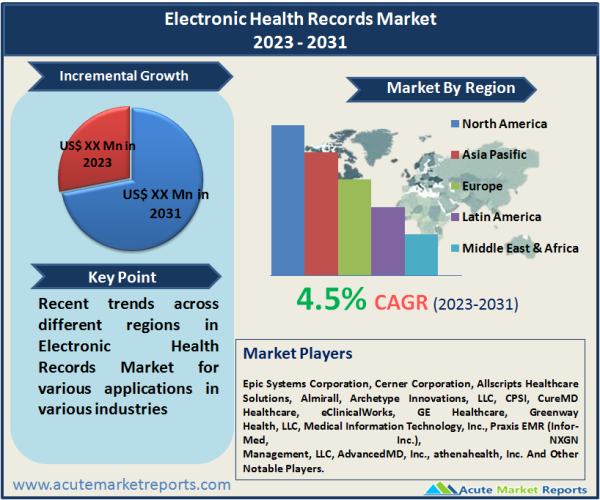
The electronic health records (EHR) market has emerged as a transformative force in the healthcare industry, reshaping the way patient information is managed and leveraged. The EHR market is expected to grow at a CAGR of 4.5% during the forecast period of 2025 to 2033. The electronic health records market is expected to continue its transformative impact on healthcare, driven by factors such as enhanced clinical decision-making, regulatory initiatives and incentives, and cost reduction and efficiency gains. The restraint of interoperability underscores the need for standardization and seamless data exchange in healthcare. The market segmentation by deployment type and application provides insights into specific areas of growth within the market, and geographic trends reflect the importance of regional variations in demand. Competitive players are expected to continue their emphasis on innovation and interoperability to meet the evolving needs of healthcare providers and organizations.

Enhanced Clinical Decision-Making
One of the primary drivers of the electronic health records market is its ability to enhance clinical decision-making. EHR systems provide healthcare professionals with immediate access to a comprehensive patient history, including medical records, test results, and treatment plans. This wealth of information facilitates more informed and accurate decision-making, ultimately leading to improved patient care. The integration of decision support tools within EHRs further augments clinical decisions by offering alerts, reminders, and evidence-based guidance.
Regulatory Initiatives and Incentives
Governmental regulations and incentive programs have played a pivotal role in driving the adoption of EHR systems. In the United States, the Health Information Technology for Economic and Clinical Health (HITECH) Act, a component of the American Recovery and Reinvestment Act of 2009, allocated financial incentives to healthcare providers who demonstrated "meaningful use" of certified EHRs. These initiatives aimed to improve the quality, safety, and efficiency of healthcare delivery by promoting EHR adoption.
Cost Reduction and Efficiency Gains
The pursuit of cost reduction and operational efficiency has been a significant driver for EHR adoption. By transitioning from paper-based records to digital systems, healthcare organizations can streamline administrative tasks, reduce manual data entry, and minimize the need for physical storage space. EHRs also enable efficient data sharing among healthcare providers, eliminating redundancies and ensuring the continuity of care. As a result, the implementation of EHR systems has the potential to yield long-term cost savings while enhancing overall operational efficiency.
Restraint in the EHR Market
A notable restraint in the electronic health records market is the issue of interoperability. Despite widespread adoption, EHR systems from different vendors often struggle to communicate and share patient information seamlessly. This lack of interoperability hinders the realization of a comprehensive and unified patient record. Healthcare providers must navigate challenges related to data transfer, format compatibility, and standards adherence, limiting the effective exchange of patient information across various settings and systems.
Market Segmentation by Deployment Type (Physician-hosted, Remotely-hosted): Remotely-Hosted Segment Dominates the Market
The EHR market can be segmented by deployment type into two categories: physician-hosted and remotely-hosted (cloud-based). In 2024, the "remotely-hosted" deployment type generated the highest revenue. Cloud-based EHR solutions gained popularity due to their scalability, accessibility, and reduced IT infrastructure costs. For the period from 2025 to 2033, the "remotely-hosted" deployment type is expected to exhibit the highest compound annual growth rate (CAGR). The scalability and flexibility of cloud-based EHR systems are anticipated to drive their continued adoption.
Market Segmentation by Application (Clinical, Administrative, Healthcare Reporting, Financing, Clinical Research): Clinical Applications Dominate the Market
The EHR market can be segmented by application into five categories: clinical, administrative, healthcare reporting, financing, and clinical research. In 2024, the "clinical" application segment witnessed the highest revenue, reflecting the primary use of EHRs for patient care management and clinical data storage. For the period from 2025 to 2033, the "healthcare reporting" application segment is expected to experience the highest CAGR. The demand for data-driven insights and regulatory compliance in healthcare reporting is projected to drive this growth.
North America Remains as the Global Leader
The EHR market exhibits geographic variations in demand and growth. Geographic trends indicate that regions with established healthcare infrastructure, government support, and a focus on healthcare digitization tend to lead in EHR adoption. North America, with its early adoption of EHR systems and regulatory initiatives, has been a prominent market for EHR solutions. When considering the region with the highest CAGR during the forecast period from 2025 to 2033, the Asia-Pacific region is expected to exhibit substantial growth. The region's burgeoning healthcare systems, increasing healthcare spending, and recognition of the benefits of EHRs are driving the demand for EHR solutions. In terms of revenue percentage, North America is expected to maintain its position as the region with the highest revenue percentage throughout the forecast period. The region's well-established healthcare practices and the implementation of regulatory initiatives contribute to its prominence in the EHR market.
Market Competition to Intensify during the Forecast Period
The EHR market features several key players, including Epic Systems Corporation, Cerner Corporation, Allscripts Healthcare Solutions, Almirall, Archetype Innovations, LLC, CPSI, CureMD Healthcare, eClinicalWorks, GE Healthcare, Greenway Health, LLC, Medical Information Technology, Inc., Praxis EMR (Infor-Med, Inc.), NXGN Management, LLC, AdvancedMD, Inc., and athenahealth, Inc. These companies employ specific strategies to maintain and expand their market presence. In 2024, Epic Systems Corporation held a significant market share, offering a comprehensive EHR platform known for its interoperability and user-friendly interface. The company's strategy focused on collaboration with healthcare providers and the continual enhancement of its EHR features. Cerner Corporation, a global EHR and healthcare technology company, excelled in providing a wide range of EHR solutions. Their strategy emphasized global expansion and partnership with healthcare systems to streamline operations and enhance patient care. Allscripts Healthcare Solutions, a prominent player in healthcare technology, positioned itself as a key player in the market. Their strategy centered on providing customizable EHR solutions that cater to the unique needs of healthcare organizations. For the forecast period from 2025 to 2033, these companies are expected to continue their strategies, focusing on innovation, interoperability, and global expansion. They will explore new technologies and products to maintain their competitive edge in the evolving EHR market.
Historical & Forecast Period
This study report represents analysis of each segment from 2023 to 2033 considering 2024 as the base year. Compounded Annual Growth Rate (CAGR) for each of the respective segments estimated for the forecast period of 2025 to 2033.
The current report comprises of quantitative market estimations for each micro market for every geographical region and qualitative market analysis such as micro and macro environment analysis, market trends, competitive intelligence, segment analysis, porters five force model, top winning strategies, top investment markets, emerging trends and technological analysis, case studies, strategic conclusions and recommendations and other key market insights.
Research Methodology
The complete research study was conducted in three phases, namely: secondary research, primary research, and expert panel review. key data point that enables the estimation of Electronic Health Records market are as follows:
Market forecast was performed through proprietary software that analyzes various qualitative and quantitative factors. Growth rate and CAGR were estimated through intensive secondary and primary research. Data triangulation across various data points provides accuracy across various analyzed market segments in the report. Application of both top down and bottom-up approach for validation of market estimation assures logical, methodical and mathematical consistency of the quantitative data.
| ATTRIBUTE | DETAILS |
|---|---|
| Research Period | 2023-2033 |
| Base Year | 2024 |
| Forecast Period | 2025-2033 |
| Historical Year | 2023 |
| Unit | USD Million |
| Segmentation | |
Deployment Type
| |
Application
| |
End-User
| |
Type
| |
Business Models
| |
|
Region Segment (2023-2033; US$ Million)
|
Key questions answered in this report